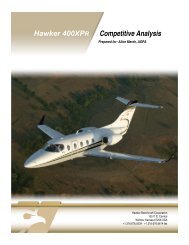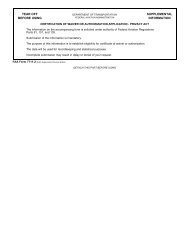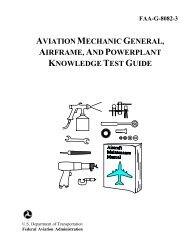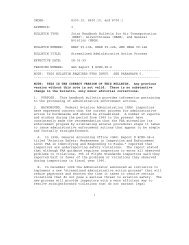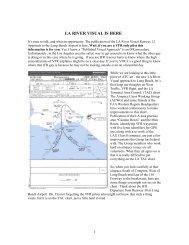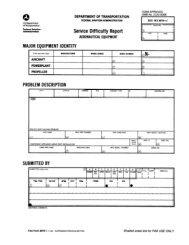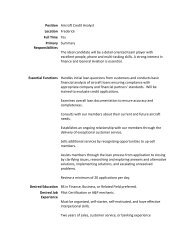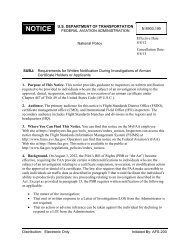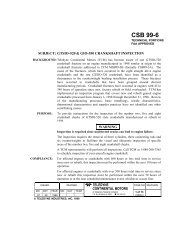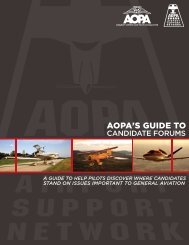2008 Nall Report - Aircraft Owners and Pilots Association
2008 Nall Report - Aircraft Owners and Pilots Association
2008 Nall Report - Aircraft Owners and Pilots Association
Create successful ePaper yourself
Turn your PDF publications into a flip-book with our unique Google optimized e-Paper software.
APPENDIX<br />
Interpreting Aviation Accident<br />
Statistics: What Is the Accident Rate?<br />
Meaningful comparisons are based on equal exposure<br />
to risk. However, this alone does not determine<br />
total risk. Experience, proficiency, equipment,<br />
<strong>and</strong> flight conditions all have a safety impact.<br />
To compare different airplanes, pilots, types<br />
of operations, etc., we must first “level the playing<br />
field” in terms of exposure to risk. The most common<br />
way to do this is to compare accidents per<br />
100,000 flight hours. GA flight hours are estimated<br />
using data from an annual aircraft activity survey<br />
conducted by the FAA. In the last few years,<br />
the FAA has made a considerable investment to<br />
improve both the accuracy <strong>and</strong> sample size of the<br />
activity survey. Whether this survey accurately reports<br />
the total hours has been debated for years,<br />
but even with likely inaccuracies, the relationships<br />
between accident categories will remain constant.<br />
For instance, l<strong>and</strong>ing accidents will still account<br />
for the majority of minor injury mishaps, while<br />
weather <strong>and</strong> maneuvering flight will still claim the<br />
most lives.<br />
Accident investigators <strong>and</strong> safety researchers<br />
determine the probability that a given accident<br />
was the result of a particular cause or sequence<br />
of events. This report shows the percentage of accidents<br />
attributed to a particular accident category<br />
<strong>and</strong> the percentage of accident sequences that<br />
began in a particular phase of flight. Thus we can<br />
identify <strong>and</strong> concentrate on accidents that carry<br />
the greatest risk.<br />
NTSB Definitions<br />
Accident/Incident (NTSB Part 830)<br />
The following definitions of terms used in this<br />
report have been extracted from NTSB Part 830<br />
of the Federal Aviation Regulations. It is included<br />
in most commercially available FAR/AIM<br />
digests <strong>and</strong> should be referenced for detailed<br />
information.<br />
<strong>Aircraft</strong> Accident<br />
An occurrence incidental to flight in which, “as<br />
a result of the operation of an aircraft, any person<br />
(occupant or non-occupant) receives fatal or<br />
serious injury or any aircraft receives substantial<br />
damage.”<br />
• A fatal injury is one that results in death within<br />
30 days of the accident.<br />
• A serious injury is one that:<br />
(1) Requires hospitalization for more than 48<br />
hours, commencing within seven days from<br />
the date the injury was received.<br />
(2) Results in a fracture of any bone (except<br />
simple fractures of fingers, toes, or nose).<br />
(3) Involves lacerations that cause severe<br />
hemorrhages, nerve, muscle, or tendon<br />
damage.<br />
(4) Involves injury to any internal organ. Or<br />
(5) Involves second- or third-degree burns, or<br />
any burns affecting more than five percent<br />
of body surface.<br />
• A minor injury is one that does not qualify as<br />
fatal or serious.<br />
• Destroyed means that an aircraft was demolished<br />
beyond economical repair, i.e., substantially<br />
damaged to the extent that it would be impracticable<br />
to rebuild it <strong>and</strong> return it to an airworthy condition.<br />
(This may not coincide with the definition<br />
of “total loss” for insurance purposes. Because of<br />
the variability of insurance limits carried <strong>and</strong> such<br />
additional factors as time on engines <strong>and</strong> propellers,<br />
<strong>and</strong> aircraft condition before an accident, an<br />
aircraft may be “totaled” even though it is not considered<br />
“destroyed” for NTSB accident-reporting<br />
purposes.)<br />
• Substantial damage – As with “destroyed,”<br />
the definition of substantial for accident reporting<br />
purposes does not necessarily correlate with<br />
“substantial” in terms of financial loss. Contrary<br />
to popular misconception, there is no dollar value<br />
that defines “substantial” damage. Because of<br />
the high cost of many repairs, large sums may be<br />
spent to repair damage resulting from incidents<br />
that do not meet the NTSB definition of substantial<br />
damage.<br />
(1) Except as provided below, substantial<br />
damage means damage or structural failure<br />
that adversely affects the structural<br />
strength, performance, or flight characteristics<br />
of the aircraft, <strong>and</strong> which would normally<br />
require major repair or replacement<br />
of the affected part.<br />
33



